Mammals
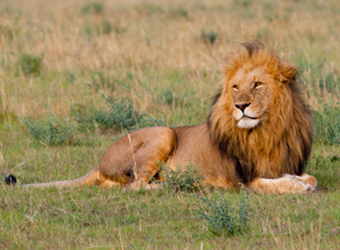
Lion
Lions are the largest of the big cats and the only really social members of the cat family. Prides are usually built around two to fifteen related lionesses and are accompanied by a coalition of males, many of whom are brothers unrelated to the females. The pride also contains dependent offspring. Young females join their mothers and aunts as breeding pride members, while young males emigrate and seek unrelated prides to attempt to take over.
Lions are widespread in wooded and bushed habitats, and although they are often seen in completely open grasslands, they prefer areas that have cover for hunting and hiding young. They are predominantly active in the evening, early morning, and intermittently through the night, and they tend to spend nearly all daylight hours resting or asleep in the shade.
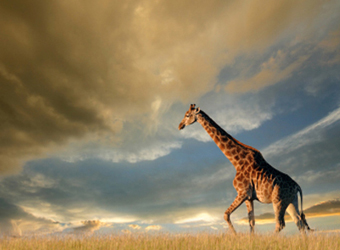
Giraffe
Giraffes inhabit open woodland and wooded grassland and weigh up to 2,200 pounds. They have a high center of gravity which, together with their weight, may account for their strange gait. A giraffe, however, can reach a maximum speed of 37 miles per hour.
Most often, the favorite diet of these graceful animals is the leaves of certain acacia trees. Giraffes are the tallest of the earth’s animals, as well as the largest ruminants (four-stomached animals) which enables them to eat relatively little and extract as many nutrients from the leaves as possible. A giraffe’s lips are used as agilely as its tongue. The black tongue is very long, up to 18 inches, and mobile enough to curl around branches. Giraffe saliva is especially thick, which undoubtedly helps in dealing with the thorny branches found on acacia trees.
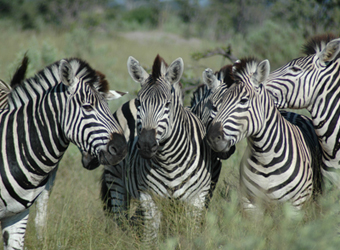
Zebra
The word ‘zebra’ in Swahili means “striped donkey”. There is quite a debate about the function of a zebra’s stripes, for which they are well known. The general opinion is that they serve as a form of visual anti-predator device, either as camouflage, or to break up form when seen from a distance.
There are a few species of zebra in Africa (Burchell’s and Grevy’s), which inhabit open and wooded grasslands. These common animals are single-stomached (non-ruminants), which allows them to feed on coarse grass largely passed over by other members of the grazing community, and thus enabling them to survive when other grazers cannot. However, like the elephant, they need to drink water on a daily basis, and hence, they are rarely found far from a water source.

Hyena
The spotted hyena, one of the species found in southern Africa, has powerful forelegs and shoulders, a long neck and a heavily built skull containing formidable teeth. Its ears are round, and as its name suggests, its coat is spotted. The brown hyena, cousin to the spotted hyena, shares the powerfully built shoulders and head, but it has longer legs, and its fore feet are much larger than its hind feet. It also has a crest of hair running down its back, culminating in a very bushy tail.
Both species are opportunistic hunters and scavengers, taking advantage of wastes left by other animals or man. Hyenas in general will take weaker or sick animals in preference to healthy ones, and will also eat the dead of almost any mammal, bird, reptile or fish, irrespective or size or species.

African Civet
The African civet inhabits the savannahs and the forests of southern and central Africa, usually close to permanent water systems. Their average lifespan is fifteen to twenty years. In southern Africa, breeding occurs in the warm, wet summer months from August to January.
Civets are solitary, except when breeding and are predominately nocturnal, however they are sometimes seen in the morning or afternoon on cloudy days. They sleep in dense thickets during the day. Only mothers with young have a nest which they build in holes made by other animals or under tangled roots. The civet is omnivorous consuming mainly wild fruit, carrion, rodents, insects (crickets, grasshoppers, beetles, and termites), eggs, reptile, and birds.
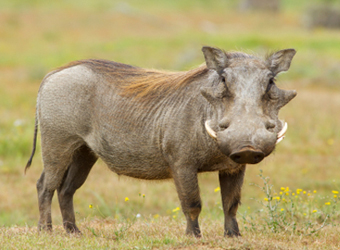
Warthog
Warthogs are found outside forested areas in Africa. They are primarily grazers but also feed on roots, berries, bark of young trees, and occasionally carrion. They are specialized for grazing short grasses due to their ability to lower themselves close to the ground on their wrist joints, which are calloused and padded. They use their snouts and tusks to excavate rhizomes and bulbs which provide water during periods of drought.
Warthogs live in family groups called soundings, usually consisting of females and their young. Males disperse after about two years of age and become solitary or form bachelor groups. They cope with high temperatures by wallowing in mud or water and cope with low temperatures by sheltering in burrows and huddling together.
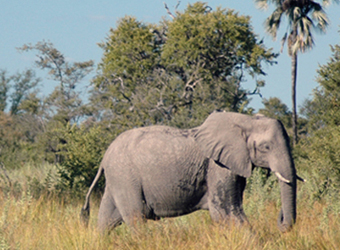
Elephant
The African elephant is the largest living land animal. Most of its special physical attributes are a consequence of its unique body size, which is ten feet at the shoulder and up to five tons in weight. These characteristics include a disproportionately large head, toe nails instead of hooves, two breasts between the forelegs, testes carried inside the body cavity next to the kidneys, specialized grinding teeth, tusks nearly worth their weight in gold, a unique trunk, enormous ears and a sixty-year life span.
Elephants once roamed freely throughout Africa, but they now occupy only one-fifth of the continent. Their range and numbers are rapidly dwindling and illegal poaching, primarily for ivory, has drastically reduced many populations. They occupy all African habitats from near desert to closed canopy forest.
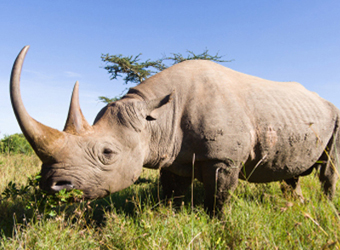
Rhinoceros
The rhinoceros is one of the most ancient mammals found in Africa. Sadly, in our lifetime, both the black and white rhinoceros, the only species found in Africa, are doomed to virtual extinction in the wild, outside of small, protected areas.
Rhinos, like horses, are odd-toed ungulates; with three large toes (their footprints are unmistakable). African rhinos have two long horns, one set behind the other. The shape of the mouths of the two rhino species indicates the differences in their feeding habits. Black rhinos are browsers and have pointed, nearly prehensile upper lips, which allow them to choose and pluck small twigs, leaves, fruit and vines. White rhinos, on the other hand, have broad, square mouths with upper lips and teeth extremely well suited for grinding grass. Over the years, both species have lost their front biting teeth altogether and rely solely upon their lips to gather vegetation.
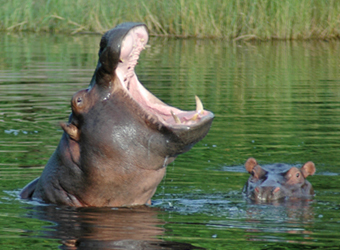
Hippopotamus
Hippos are the second-largest terrestrial mammals, weighing up to 4,400 pounds, with barrel-shaped bodies and short legs. Their heads are well adapted for life in the water, with their eyes, ears and nose all situated on top of their head.
Hippos live in still or slow-running water with frequent bends in the shoreline, and deep pools with shallow-sided banks, in the midst of open wooded or bushed grassland. They are grazers and feed at night, coming out of the water along well-worn trails. They spend the entire day in the water, either totally or partially submerged, floating beneath the surface and bouncing from the bottom to the surface to breathe every few minutes.
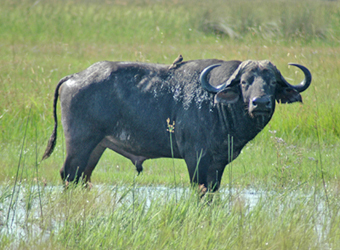
Buffalo
Cape buffalo are strictly grazers and are most active in the evening, night and early morning, both for feeding and traveling. The rest of their time is spent in the shade (if available), lying down and ruminating, rather like cows in a field. Buffaloes must drink daily, so are never found more than nine miles from a water source. As with domestic cattle, buffalo probably do not sleep more than an hour a day.
The massive, bossed horns and exceptional size of the buffalo afford considerable protection. A buffalo herd, when in danger of attack by lions, will form a defensive semi-circle, protected by bulls on the outer flank, with the cows and calves grouped in the center of the formation.
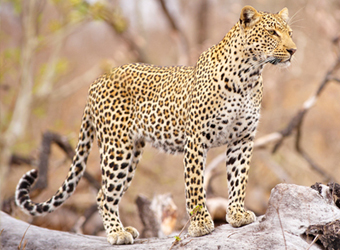
Leopard
Leopards are the largest of the spotted cats. Their heavy build, pugmark spots and thick, white-tipped tail distinguish them from the more slender cheetah. They are the most elusive of the large cats, principally because of their nocturnal and secretive habits. They are found in all except the very driest of African habitats. They are the most widespread members of the cat family. Large rocks, kopjes and large trees along rivers are favorite resting sites. As long as there is an adequate food supply and a minimum of persecution from outside sources, the leopard is at home.
Leopards are solitary creatures. They occupy and defend home ranges, which vary from one to twelve square miles, depending on the availability of food. Males and females defend their own, often overlapping, territories from members of the same sex.
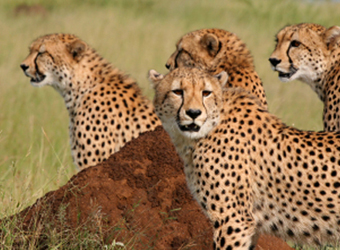
Cheetah
Cheetahs are lean, muscular cats, approximately ninety to 130 pounds in weight. Their silhouette is long and lanky, and they have spotted coats and a “tear stripe” running from eye to cheek. They are the most endangered of the three large cats, perhaps because unlike leopards, they are unable to adapt easily to the changes wrought to their habitat by man, who is gradually forcing them into marginal areas.
Cheetahs are generally silent, solitary animals, except for consorting pairs and females with dependent offspring. In addition, young animals that have recently left their mothers tend to stay together for a time, as well as males who sometimes temporarily band together to defend a territory. They prey mainly upon relatively small animals, such as impala, relying on sight to locate, stalk and initiate pursuits. Groups of males, however, are capable of taking on larger animals, such as wildebeest.
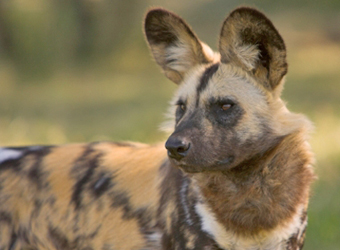
African Wild Dog
There has been an extraordinary amount of attention given to the African wild dog – the sub-region’s most endangered carnivore – in the last decade. Their numbers have plummeted so quickly that drastic and dramatic conservation efforts have been enforced. Currently, there are maybe only 2,000 left in the wild. Wild dog packs usually consist of a dominant breeding pair, five to six other adults and dependent young.
Typically found in savanna, grassland and woodland, wild dogs weigh approximately fifty-five pounds. Large, rounded ears allow the dogs to hear over long distances They are surprisingly vocal creatures. A bird-like yettering is often heard when the dogs greet one another. Alarmed dogs will bark, and distressed pups occasionally give a squeaky “hoo” call. Wild dogs are generally ignored by lions, but they will feed on the dogs’ kills after chasing them off, if they are able to do so.
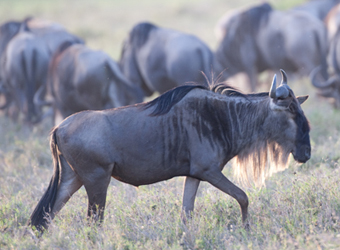
Wildebeest
The wildebeest, also known as the gnu, is a territorial, gregarious animal. Because of its appearance and spirited behavior, Dutch settlers in South Africa named the animal wildebeest, meaning ‘wild beast’. Wildebeest have a large box-like head and a disproportionate looking body with a heavily built front end, slender hindquarters and spindly legs.
Wildebeest are continually on the move as they seek favorable supplies of grass and water. Active both day and night, they often string out in long single columns when traveling. They also cover long distances at a slow rocking gallop, but are able to run fast when necessary. During their annual migration in East Africa, which begins after the calving season in January and February, they are relentless in their advance, and will swim rivers and lakes in such huge masses that many are injured, lost (especially in the case of calves) or killed.
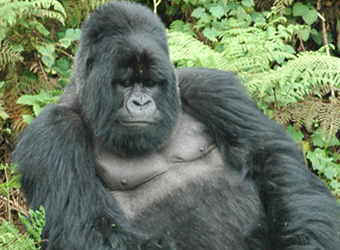
Mountain Gorilla
The mountain gorilla is a seriously endangered species, with a population of only about 740 left in the upper elevations of Rwanda, Congo and Uganda. The total estimated number of all free-living gorillas in the world is under 50,000. Dian Fossey devoted her life to protecting these majestic creatures, organizing anti-poaching campaigns, working with local governments and conducting research.
Mountain gorilla groups range in size from four to over thirty gorillas of all ages. Each group is led by a silverback, usually the largest or strongest of the group. The silverback decides when the group will move, when it will stop, where it will rest, and where it will sleep for the night. Sleeping nests are made of branches and vines, broken or bent to form a crude bowl. Each nest is used only once, since gorillas move on to a new nesting site each night.

Chimpanzee
Among the apes, it is the chimpanzees that can tell us most about the natural history of our common ancestors. In chimpanzee behavior, we see many similarities to people, such as tool making and the aggressive raiding parties of males. Chimpanzees have similar sensory abilities to humans and are possibly even better able to distinguish smells.
Chimpanzee diets are composed mainly of ripe fruits, which they eat for at least four hours a day. One to two hours daily are spent eating young leaves, particularly in the late afternoon. Chimpanzees travel mostly on the ground, where they “knuckle-walk,” like gorillas. Like the other great apes, chimpanzees sleep in “nests”—leafy beds normally made fresh each night. Adults sleep alone and infants sleep with their mothers until the next sibling is born.
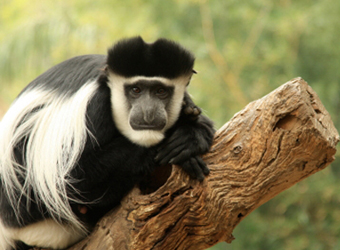
Colobus Monkey
The Colobus monkey, sometimes referred to as the “leaf eater,” derived its common name centuries ago from the Latin word colobus, meaning “mutilated.” European explorers originally believed that their thumbs were removed as a part of local ritual, while, in fact, they are more or less thumbless.
Colobus monkeys are often characterized by their loud calls, which are generally most intense and most contagious at dawn. The calls may also be heard during the day, especially during preparation for troop movement, finalization of nighttime sleeping positions, and in some cases, during the night. Although they start life with a complete coat of short white fur, at about four months of age they begin to develop the black fur markings that make them so distinct.
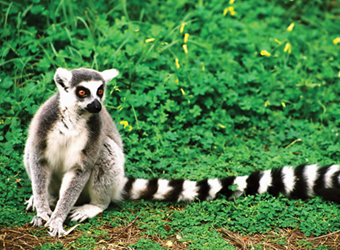
Lemur
Madagascar and the tiny Comoro Islands to its north provide the world's only present-day native habitat to lemurs. There are currently ninety living species of lemur and they are all endangered due to the rapid destruction of their forest habitat. The word Lemur refers to ghosts or spirits in Old Latin. The staring eyes, haunting sounds, and nocturnal ways of the lemur inspired early observers to think of them as ghosts or forest spirits.
Like human beings, lemurs are primates, though they are considered much more primitive because they share characteristics with early ancestral primates. Most are active during the day and live in family groups or large troops. Lemurs are very clean animals and spend a lot of time grooming themselves and each other.
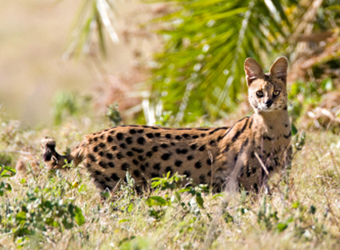
Serval
African servals, originally found throughout Africa, now predominantly reside in southern Africa, especially in Zimbabwe and the province of Natal. Their coat has a copper hue and their legs and ears are long and considered the largest in the cat family relative to their size. They have black spots and stripes, which vary among each individual in size and placement.
Servals hunt during early morning and late afternoon and rest at mid-day and occasionally at night. They are solitary animals, only interacting with other members of their species when mating, caring for young, or fighting for territory. Increasing human populations and agricultural development have reduced habitat for both African servals and their prey.
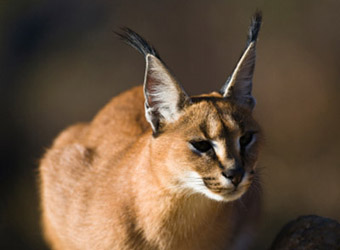
Caracal
Distributed over much of Africa, caracals have brown to red coats, with color varying among individuals. Their trademark features are their elongated and black-tufted ears. Like other felids, caracals have well-developed senses of hearing and sight. Camouflage is a primary defense against predators. When threatened in their preferred, open habitats, caracals lie flat and their plain, brown coats act as instant camouflage.
Parental investment in caracals plays a large role in greater reproductive behavior. The time a mother spends with her kits (and the combined lack of post partum estrus) restricts females to one litter per year. Once the young are conceived, males play no role in their direct or indirect care. Females invest a great deal of time and energy into their young.
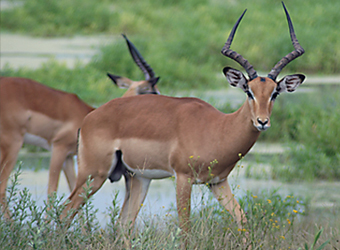
Impala
Impala are found from northeast South Africa to Angola, south Zaire, Rwanda, Uganda, and Kenya. The males have S shaped horns that are heavily ridged and thin and have tips that lie far apart. Both sexes have black stripes down the tail, forehead, both thighs, and eartips which are thought to aid in recognition between individuals. They feed mostly on grass during times of lush growth following the rains and switch to browsing during the dry season.
Impala are diurnal with peak activity times for social activity and herd movement shortly after dawn and before dusk. They use various anti-predatory techniques, most commonly to outrun or confuse the predator. They can leap up to ten feet in the air, often moving in different directions and sometimes landing on their front legs while kicking their hind legs to release a scent that is thought to help them stay together.
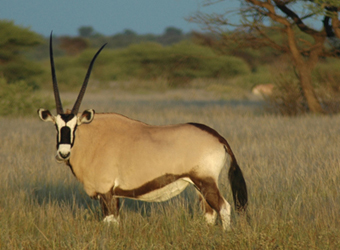
Gemsbok
Gemsbok are found mostly in southern east Africa. They are large bovids with very thick, muscular necks, covered in dense, inelastic skin. Black markings on the face extend down from the base of the horns to above the muzzle, and sweep back in stripes over the eyes and cheeks. Black continues down the neck and around the underbody, forming bands around all four legs.
There is not a specific breeding season for gemsbok, though young within a herd tend to be of similar ages. They are classified as "hiders", meaning the young are not seen present with the mother, but are hidden in the general vicinity, with the mother returning to nurse the calf two to three times each day. They prefer stony plains with at least limited water access, but can subsist in areas of dunes, rocky mountainous areas, and arid habitats with little seasonal water.
